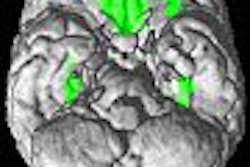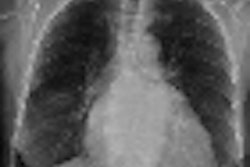
Eating disorders affect growing numbers of people, but many sufferers hide their condition and fail to seek active treatment. To combat the problem, radiologists can play a key role in identifying undiagnosed patients, as well as reducing morbidity and mortality in this challenging patient group, an RSNA 2011 study has found.
An estimated 70 million people worldwide suffer from an eating disorder, including anorexia nervosa, bulimia nervosa, and binge-eating. There are around 24 million sufferers in the U.S. alone. Among 15-year-old girls, for instance, about 1 in 150 suffers from anorexia. Up to 20% of women struggle with an eating disorder or a disordered eating pattern, and women account for 85-90% of those with anorexia or bulimia. Only 10% of sufferers generally receive treatment, according to Dr. David Bowden, radiology registrar at Addenbrooke's Hospital in Cambridge.
 About 1 in 150 girls age 15 suffers from anorexia, yet very few of them feel they can discuss their problem with anybody.
About 1 in 150 girls age 15 suffers from anorexia, yet very few of them feel they can discuss their problem with anybody.
"Underdiagnosis of eating disorders remains a significant issue," noted Bowden, lead author of an education exhibit on this topic that received a prestigious Magna Cum Laude award at the RSNA. "An individual may have an eating disorder or body image issues and not fulfill the diagnostic criteria. As a result, diagnosis may be delayed or not achieved at all."
Eating disorders have the highest mortality of any mental disorder, he added. About 20% of anorexia sufferers will die prematurely from complications relating to their illness, and more than 90% of children with an eating disorder feel unable to disclose their condition.
Almost all organ systems are adversely affected by the complications of eating disorders, and the results may be fatal. Osteoporosis is common, but its etiology in eating disorders is complex and multifactorial, including deranged hormone levels (estrogen, cortisol) and poor nutrition, wrote the authors. Women normally develop up to 60% of their normal bone mass during adolescence, which coincides with the peak incidence of eating disorders.
"More than half of all women with anorexia develop osteoporosis, often with a rapid onset," Bowden pointed out. "A duration of illness greater than 12 months has been shown to predict significant loss in bone density. Poor bone mass early in life increases fracture risk later in life; early diagnosis is therefore essential. Bone mineral density is reduced below the fracture threshold in up to 75% of patients."
Vertebral wedge compression fractures are most likely in the region of the thoracolumbar junction, due to axial loading forces, and excessive exercise further increases the risk of insufficiency fractures. Although dual x-ray absorptiometry (DXA) is the most commonly used method for assessing bone mineral density, CT studies correlate well with DXA results. Measurement of bone attenuation should be considered if there is clinical suspicion of osteoporosis in young patients.
Marrow signal intensity should be routinely assessed for evidence of abnormal conversion, potentially indicating a deranged nutritional state, he noted. Furthermore, unfused apophyses seen at an abnormal age may be indicative of an underlying eating disorder that started during adolescence and has persisted. Awareness of their presence is important; many patients with undiagnosed eating disorders may have plain radiography of the abdomen performed for abdominal symptoms.
Eating disorders also result in a wide range of gastrointestinal complications, extending throughout the entire gut from the oral cavity and the salivary glands to the anus and rectum. Many are demonstrated radiographically while others (e.g., dental enamel damage, melanosis coli) are radiographically occult, the authors wrote.
Parotid gland swelling occurs in up to 15% of patients with bulimia. The etiology is unclear, but may be secondary to an autonomic neuropathy. Subsequent accumulation of zymogen, the precursor of amylase, leads to parotid gland hypertrophy and swelling. CT or MRI of the head may demonstrate parotid gland enlargement, increased density on unenhanced studies (CT), and increased enhancement following contrast medium, secondary to hypertrophy with increased vascularity, they explained.
Up to 60% of patients with anorexia or bulimia have gastric dysmotility, and muscular atrophy and atony tend to occur after periods of starvation. Abnormally slow stomach emptying is often evident, probably due to deranged autonomic nervous function and reduced cholecystokinin levels. Increased gastric capacity contributes to the risk of acute onset gastric dilatation following binge eating.



















